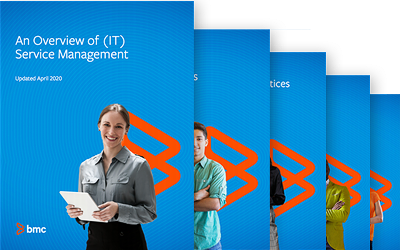Here’s a question I get often. If you’re running your IT services using a service integrator model, such as SIAM, do you still need to have an IT service management practice?
Yes!
While you may outsource the actual provisioning of IT services to third parties, you must never outsource the accountability for these services. This accountability needs to rest with your in-house ITSM capability. ITIL provides a very good model to do this. So, let’s explore the relationship between SIAM and ITIL.
What is SIAM?
Service integration and management (SIAM) is a management methodology. It can be applied in any environment where you source services from multiple service providers—outsourcing. SIAM provides you structure to aggregate and manage the partners who supply parts of your IT platform and infrastructure.
There are four common models you can employ:
Internal service integrator
In this model, a service integrator role is responsible for the coordination of third-party suppliers. This model is cost effective, and it keeps control within the organization.
One major disadvantage, however, is that the person in the role may not have (or be seen to have) the authority to perform the role successfully. Another issue is that most organizations are unlikely to have the appropriate skills in-house to undertake this specialist role, so there will be a steep learning curve and a longer run-up to effectiveness
External service integrator
In this model, your company contracts a specialist supplier to independently undertake the service integrator role. The service integrator is solely dedicated to the function, which isn’t always the case for in-house staff, and they are expected to have significant experience in managing these relationships. The obvious disadvantage is significant cost overheads.
Hybrid service integrator
In a hybrid model, you keep some supplier management in-house and contract some to an external service integrator. This reduces the costs associated with the external service integrator model. But, when multiple vendors are associated with a single service, confusion about responsibility results.
Lead supplier as service integrator
Here, one key supplier, often the supplier of key infrastructure and platform services, manages all other suppliers.
This is a high-trust model: the organization receiving the services must be confident that the lead supplier will not take advantage of the service integrator position. Where this trust exists, you have a very cost-effective and successful model.
Accountability for your ITSM
None of these models delegates the accountability for service management to the external providers. ITIL is all about providing a value chain for the provision of IT services—and SIAM manages one part, albeit a critical part, of this chain.
A successful SIAM implementation will, almost without exception, form part of an effective ITIL-based service management initiative. Rather than being mutually exclusive, ITIL and SIAM are, in fact, important components of the same IT ecosystem. It would be difficult for either to be successful without the other.
- In the in-house and hybrid models for SIAM, the SIAM function would likely perform ITIL’s supplier and contract management practices.
- In the external supplier and lead supplier models, the integrator would handle supplier and contract management, but the accountability remains with the in-house ITIL practice owners.
With even the smallest organizations normally relying on multiple vendors and internal service providers to deliver their IT capabilities, SIAM and ITIL need to have a close and happy marriage in order to deliver value to the business. For effective SIAM implementation, consider refocusing and reinterpreting core ITIL principles, methods, and techniques, adapting and adding to them where necessary.
Common challenges
While all this sounds easy in principle, like any good marriage there will be difficulties in getting the balance right. The most common problem is a lack of clarity around the boundaries of service integration and service management. For this reason, establish and implement a clear matrix of responsibility and accountability.
Think about what happens when you have a major incident that involves multiple vendors.
- Who is responsible for bringing the right people into the room to get service restored?
- Who is accountable for ensuring that external providers meet their obligations?
I am not going to give you an answer for this: those are the decisions you need to make for your own organization. Like all service management practices, there is no one size fits all. You must examine your own organization and decide how you want to work.
ITIL and SIAM in the real world
What I can do is give you an example of how I have seen this work in practice and identify some of the pitfalls you may encounter.
When working on a major incident that was having a significant impact on productivity throughout the organization, we identified that there were multiple vendors who played a part in delivering the service to our customers. Without an established SIAM practice, it was unclear who owned the relationship with these vendors. This caused significant delays in getting the right people in the room. A post-incident review identified this gap in knowledge and lack of anyone with a cohesive cross-vendor knowledge of relationships as a critical factor in the extended period of service unavailability.
As a solution, this organization opted for a hybrid SIAM approach, using a lead vendor to take responsibility for aggregating all vendors involved in supporting services based on the platform they provide to the business. An internal SIAM function was also stood up to work with the vendor and to aggregate internal service providers and other third-party suppliers.
This approach has, to date, greatly improved the coordination of suppliers when major incidents occur. There are clear lines of responsibility and a comprehensive knowledge of supplier interactions. This way of working has delivered an overall improvement in the downtime experienced by customers as a result of major incidents.
In today’s complex IT environments, a successful marriage of SIAM and ITIL can provide a strong basis for effective management of multi-vendor eco-systems giving clear boundaries of responsibility and accountability.
Additional resources
For more on this topic, see these resources:
- BMC Service Management Blog
- ITIL 4 Guide
- An introduction to Service Integration and Management and ITIL® (PDF), by Kevin Holland, published by Axelos, January 2015







